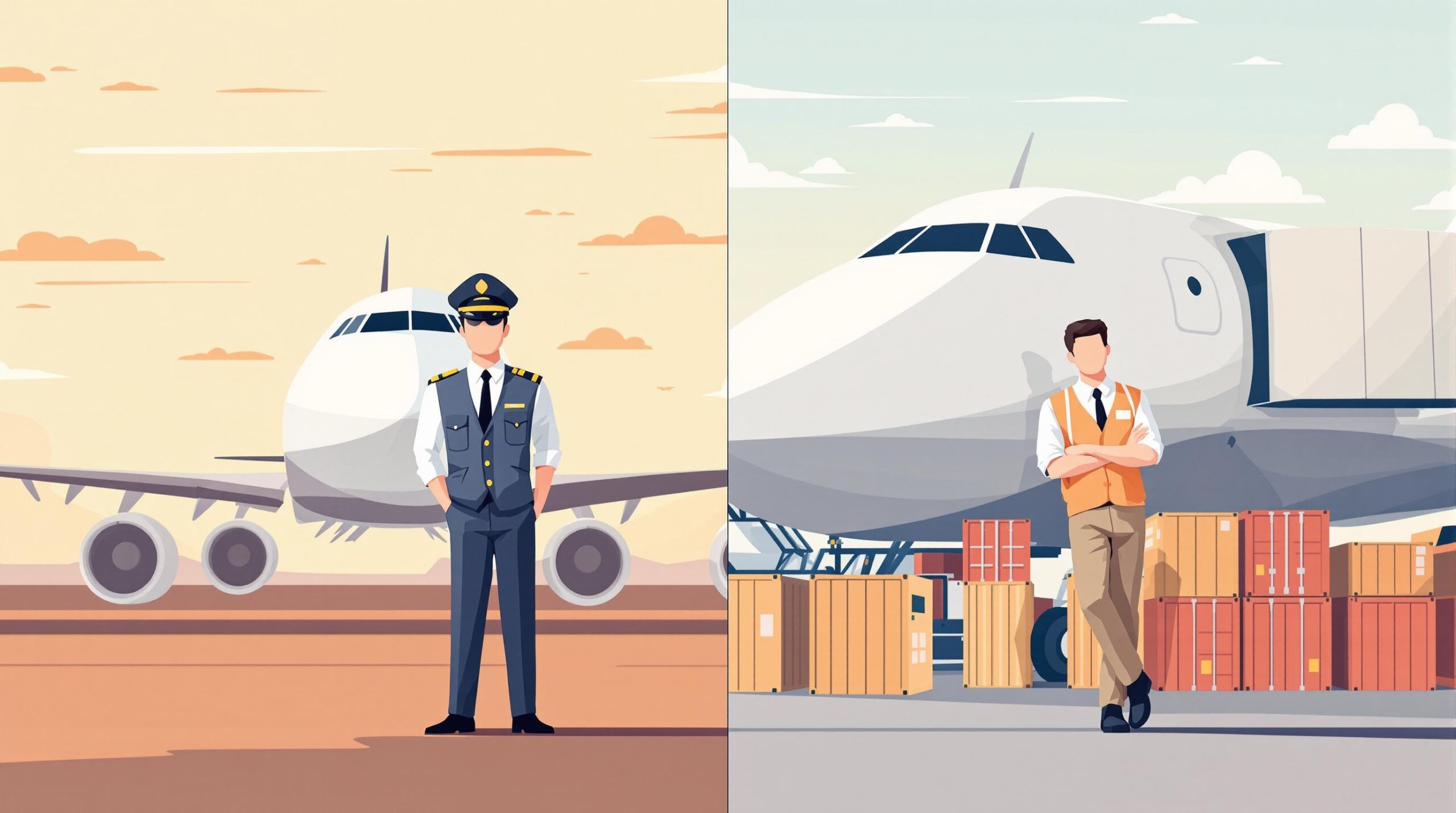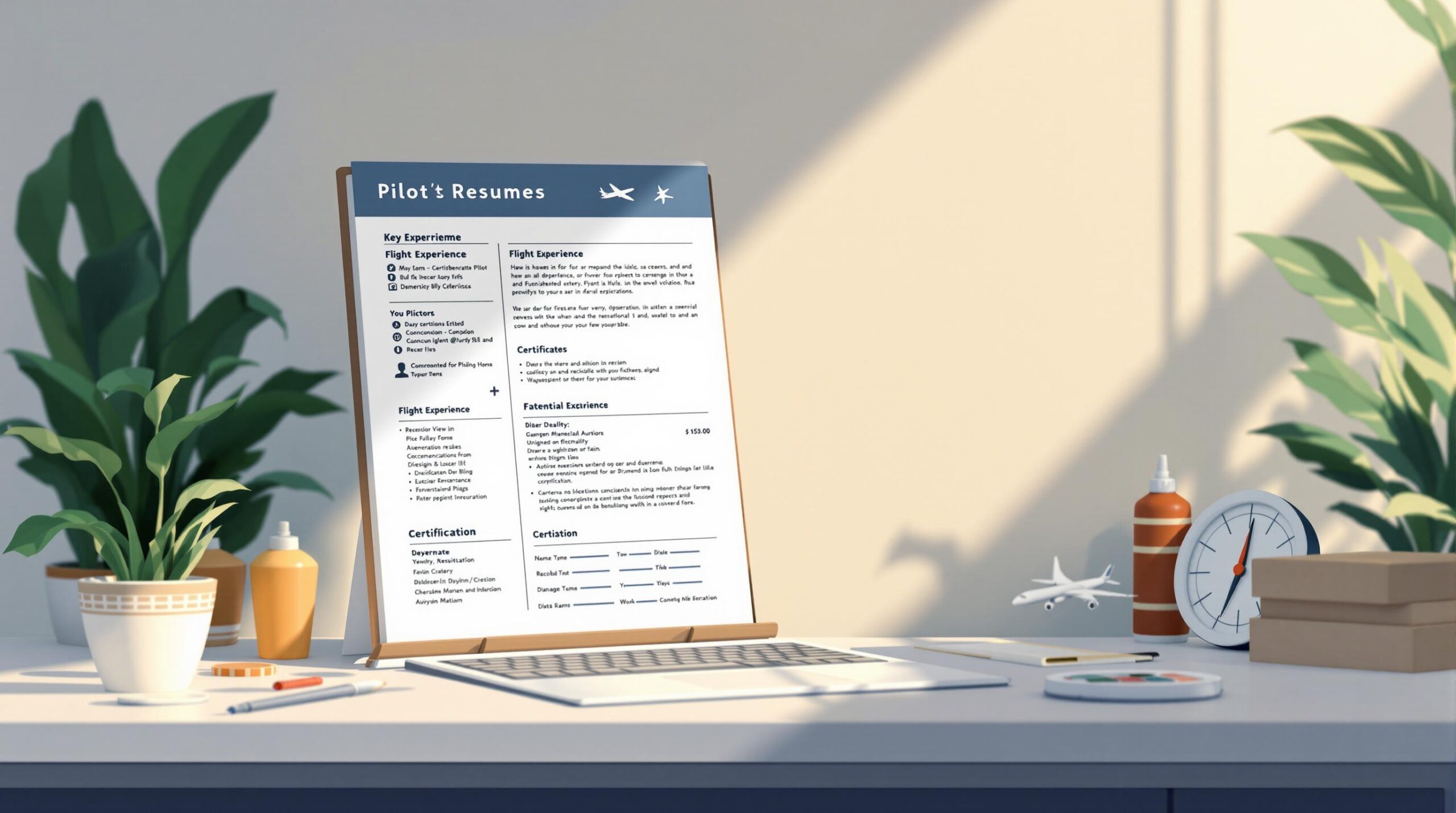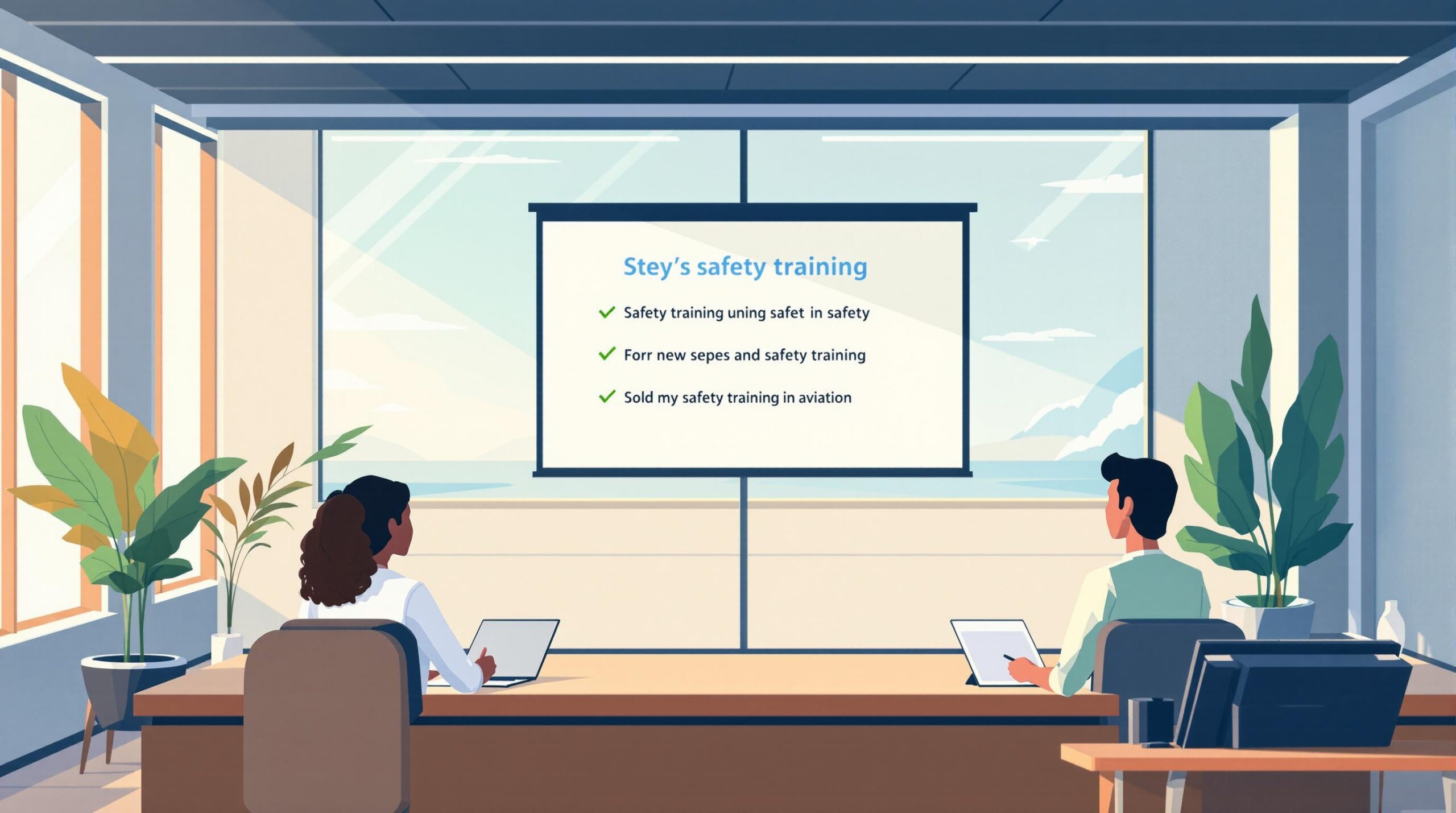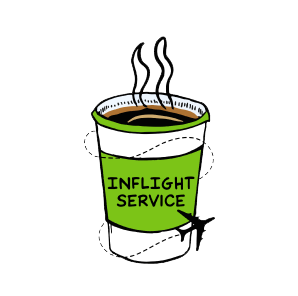Preparing for an airline pilot interview? Here’s a quick breakdown of what to expect and how to succeed:
-
Describe Yourself
- Focus on flight experience, teamwork, and safety.
- Example: Share specific scenarios showcasing leadership and clear communication.
-
Handling Emergencies
- Show your ability to stay calm, follow protocols, and prioritize safety.
- Example: Detail actions taken during a real in-flight emergency.
-
What Being a Professional Pilot Means
- Highlight safety-first thinking, leadership, and continuous learning.
- Example: Emphasize your dedication to protocols and teamwork.
-
Managing Fatigue
- Discuss strategies like proper rest, nutrition, and task-sharing.
- Example: Reference FAA rest rules and in-flight alertness techniques.
-
Explaining Technical Concepts
- Clearly explain aviation rules or systems, like Decision Altitude or RVSM.
- Example: Use simple, clear language to showcase technical knowledge.
Quick Tip: Combine technical expertise with strong communication and leadership skills to stand out. Airlines value safety, teamwork, and problem-solving above all else.
Related video from YouTube
1. How Would You Describe Yourself?
This key interview question helps recruiters evaluate your flying skills and how well you’ll fit into the airline’s team.
Think of it as your chance to paint a clear picture of who you are as a pilot. Here’s what matters most:
| Focus Area | What to Show | Example |
|---|---|---|
| Flight Experience | Certificates, hours, roles | ATP certificate, 3,000 hours, previous airline work |
| Personal Skills | Team leadership, clear communication | How you work with crew members |
| Safety Focus | How you make decisions | Following protocols, putting safety first |
"In pilot interviews, balance technical expertise with interpersonal strengths", notes Embry-Riddle Aeronautical University’s Career Services.
Don’t just list your achievements – tell your story. For example: "After earning my ATP certificate and accumulating 3,000 flight hours, I’ve not only honed my technical skills but also strengthened my ability to lead and communicate effectively with diverse teams."
Show Your Experience in Action Share a quick story about how you handled a tricky situation or worked with your team. Maybe it’s about that time you managed an unusual situation during takeoff, or how you kept everyone in sync during bad weather. These real examples show how you think and work.
Make it Personal When talking about teamwork, pick specific moments that show your leadership style. Did you help coordinate a complex situation with ground crew? How did you keep communication clear during a busy flight? These details help paint a picture of you as a professional pilot.
2. Can You Share an Example of Handling an In-Flight Emergency?
This question puts your cool-headedness and safety-first mindset to the test during high-stakes situations.
Picture this: You’re in the hot seat, and the interviewer wants to know how you perform when things get tough. Here’s how to nail your response:
Show Your Problem-Solving Skills: Break down your emergency response step by step, focusing on how you kept your cool and followed protocols.
Highlight Your Leadership: Tell them how you took charge, worked with your crew, and kept everyone in the loop.
Keep Safety Front and Center: Make it clear that passenger and crew safety was your top priority throughout the incident.
Here’s what airlines really want to hear about:
- Technical Know-How: Show them you know your stuff – from emergency checklists to aircraft systems
- Cool Under Fire: Explain how you stayed level-headed and led your team through the crisis
- Clear Communication: Describe how you kept everyone informed – from ATC to passengers
Let’s look at a solid example answer:
"During a flight from New York to Los Angeles at 35,000 feet, we encountered severe turbulence that caused passenger injuries and cabin equipment damage. I immediately alerted ATC, coordinated with my co-pilot to stabilize the aircraft, and requested diversion to the nearest airport. We ensured passenger safety and provided first aid."
When telling your story, use this structure:
- Set the scene (flight conditions, what went wrong)
- Explain what needed to be done
- Walk through your actions
- Share the outcome
Remember: The best answers show both your technical skills and your ability to lead when it matters most.
| Response Element | What to Include | Why It Matters |
|---|---|---|
| Context | Flight details, emergency type | Sets up your story |
| Protocol | Safety procedures followed | Shows expertise |
| Actions | Your response steps | Proves leadership |
| Outcome | How it was resolved | Demonstrates success |
Being ready for emergencies is crucial, but it’s just one piece of what makes a great pilot. The role demands much more than just handling the unexpected.
3. What Does Being a Professional Pilot Mean to You?
This interview question digs deep into your values and how well they match what airlines want in their cockpit crew.
Think beyond the obvious "I love flying" answer. Airlines want to see how you blend safety-first thinking with real leadership skills. It’s about doing the right thing – following every rule and checklist – even at 3 AM when no one’s looking. And when things don’t go as planned? A true pro steps up and owns it.
Here’s what makes a pilot stand out:
| Quality | Daily Practice | Why It Counts |
|---|---|---|
| Safety First | Following every protocol, no shortcuts | Keeps everyone on board safe |
| Cool Under Fire | Clear commands, staying calm when things get tough | Keeps the crew working as one |
| Always Learning | Keeping up with new rules and tech | Makes sure you’re at your best |
When you answer this question, show you get what airlines really care about. Here’s a solid example:
"As a professional pilot, I believe in maintaining the highest safety standards while delivering exceptional service. This involves mastering technical skills and staying updated through ongoing training."
Remember, you’re not just flying a plane – you’re part of a bigger picture. Your answer should touch on:
- How you make safety your top priority in every choice you make
- The way you work with your crew to keep things running smoothly
- Your understanding that at the end of the day, this is about serving passengers
Think of it this way: When passengers step on your plane, they’re putting their lives in your hands. They need to know they’ve got a pro in the cockpit who takes that trust seriously.
sbb-itb-de05b1b
4. How Do You Manage Fatigue on Long Flights?
Managing fatigue isn’t just about staying awake – it’s about keeping your mind sharp throughout long flights. Airlines need their pilots to handle tiredness effectively to keep everyone safe in the air.
Before takeoff, pilots need a solid game plan. This means getting proper sleep that meets FAA rules, eating the right foods at the right times, and knowing when (and when not) to have that cup of coffee.
Here’s what smart pilots do to stay alert:
| What to Do | How to Do It |
|---|---|
| Sleep Smart | Follow FAA rest rules, get quality sleep before flights |
| Watch What You Eat | Choose filling, energy-steady meals, time your coffee breaks |
| Stay Sharp in the Air | Work with your co-pilot, drink water, take quick mental breaks |
The best pilots don’t just wing it – they actively manage their energy during flights. One experienced pilot puts it this way:
"To manage fatigue effectively, I follow a structured approach that includes regular hydration checks, strategic task-sharing with my co-pilot, and brief mental reset periods during lower workload phases of the flight."
Airlines back this up with their Fatigue Risk Management Systems (FRMS). These systems aren’t just paperwork – they’re real tools that help keep pilots fresh and focused. They cover everything from how crews get scheduled to what happens when a pilot feels too tired.
When pilots feel unusually tired during a flight, they don’t try to tough it out. They speak up right away through their airline’s reporting system. It’s not about looking tough – it’s about keeping everyone safe.
5. Can You Explain a Technical Aviation Concept or Rule?
Airlines like United and Delta often ask pilots to explain technical concepts during interviews. Why? Because pilots need to break down complex information for different audiences – from air traffic controllers to cabin crew.
Here’s how to nail this type of question:
Pick something you KNOW cold Choose a concept that matches the airline’s operations. Going for an international carrier? Talk about Reduced Vertical Separation Minimums (RVSM). Interviewing with a regional airline? Focus on weather minimums instead.
| Topic | Best Fit | Why |
|---|---|---|
| RVSM Rules | International Airlines | Shows you get global ops |
| Weather Minimums | All Airlines | Everyone deals with weather |
Make it crystal clear Skip the jargon and explain things like you would to a friend. Here’s how you might explain Decision Altitude (DA):
"Decision Altitude is the specific point during an instrument approach where pilots must make a critical choice – either continue to land if they have the required visual references, or execute a missed approach if they don’t."
Connect it to real flying Don’t just recite facts – show how they matter in the real world. Take RVSM: explain how it lets more planes fly safely in the same airspace. This shows you don’t just know the rules – you understand why they exist.
Stay focused Pick ONE concept and explain it well. It’s better to go deep on a single topic than to bounce around between different ideas. This shows you’ve got solid knowledge and can explain it clearly – exactly what airlines want to see.
Conclusion
Tips for a Successful Interview
Want to know what makes pilots stand out in airline interviews? According to Pilot Pathfinder‘s 2024 analysis, candidates who put in the work to prepare for both behavioral and technical questions are three times more likely to get job offers. Major airlines like United and Delta now look beyond just flying skills – they want pilots who can handle both the technical side and work well with others.
Here’s what airlines really care about when they’re sizing up candidates:
Technical Know-How Can you break down complex aviation concepts into simple terms? This matters because you’ll need to communicate clearly with different crew members every day. Skip the jargon overload and focus on being clear and direct.
Real-World Problem Solving Airlines want to see how you think on your feet. When they ask about emergencies or dealing with fatigue, don’t just give textbook answers. Share actual examples that show how you make decisions and stick to safety rules.
| What They’re Looking At | What They Want to See | Why You Should Care |
|---|---|---|
| Technical Knowledge | Can explain things simply | Shows you can communicate well in the cockpit |
| Safety & Leadership | Smart risk handling and teamwork | Proves you can make good calls and work with others |
Keep Learning Big names like American Airlines love seeing pilots who keep pushing themselves to learn more. Whether it’s new certifications or extra training, show them you’re committed to getting better.
"The most successful candidates demonstrate not just technical expertise, but also strong communication skills and a clear understanding of airline operations", notes Pilot Pathfinder’s Chief Training Officer in their 2024 Industry Insights Report.
Additional Tools and Resources
Pilot Pathfinder

Looking to streamline your journey to becoming an airline pilot? Pilot Pathfinder offers a digital toolkit that makes interview prep and application tracking much easier. Their Pro plan costs $29.99/month and packs everything you need to nail those pilot interviews.
Here’s what you get with Pilot Pathfinder:
| Feature | What It Does |
|---|---|
| Application Automation | Fills out airline applications for you |
| Digital Logbook | Keeps your flight records safe and organized |
| Interview Practice | Tests you with real-world scenarios |
The browser plug-in works right alongside airline job portals, so you’ll always know where you’ve applied and what’s coming up next. For military pilots making the switch to commercial flying, there’s a special tool that converts your military hours into civilian format – super helpful since military flight logs use different standards than airlines require.
"Preparation is key. Reviewing all necessary documents and maintaining a professional demeanor are crucial for a successful pilot interview", notes a recent analysis from Blog.flyhaa.com.
Want to try before you buy? Pilot Pathfinder lets you test drive their basic features for free, including an aviation-focused resume builder.
Quick Tip: Make the most of Pilot Pathfinder’s interview practice tools – they’ll help keep your interview game strong throughout your aviation career hunt.
FAQs
What type of questions are asked in a pilot interview?
Pilot interviews dig into three main areas: your technical know-how, how you handle tricky situations, and your past behavior on the job.
For the technical part, expect questions about how planes work, flying procedures, and aviation rules. They might ask you to explain how different weather affects your flight – like what you’d do if you hit unexpected turbulence.
When it comes to behavior, they’ll want to hear about times you’ve shown leadership or handled tough situations. And don’t be surprised if they throw some pressure-cooker scenarios at you to see how well you think on your feet.
What questions are asked in a pilot scenario interview?
In scenario interviews, you’ll face real-world flying challenges. Picture this: "Your engine fails right after takeoff – what do you do?" These questions test how well you can solve problems when things get sticky.
Here’s what interviewers look at during different scenarios:
| Scenario Type | What Interviewers Evaluate |
|---|---|
| Safety Hazard Management | How you spot and handle risks |
| Emergency Response | Your split-second thinking and knowledge of procedures |
| Crew Dynamics | Your people skills and ability to handle conflicts |
| Decision Making | How you prioritize safety in tough calls |
"Preparation is crucial for scenario-based questions. Candidates should focus on demonstrating their ability to think critically and make sound decisions under pressure while maintaining safety protocols."
Pro tip: When answering these scenarios, walk through your thinking step-by-step. Show how you:
- Spot the problem
- Talk it through with your crew
- Pick the best solution
- Keep safety front and center




